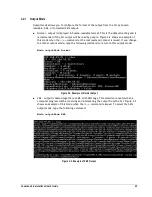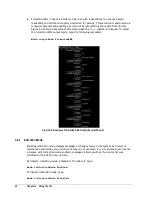
36
Chapter 4 Global Action Commands
4.2.2
Echo
Use the
Echo
command to echo command lines to Standard Out (STDOUT). When enabled, a
copy of each command line you issue is sent to STDOUT. By default, echo is disabled. Issuing
this command enables echo. Issuing the command again disables echo.
Because
Echo
writes to STDOUT, it can be redirected.
Syntax
Echo
Examples
Echo
Enables echo to STDOUT (if echo was disabled) or disables echo to STDOUT (if echo was
enabled).
Help Echo
Displays help for the
Echo
command.
4.2.3
Execute
Use the
Execute
command to execute a text file containing one or more CLI command
lines. Adding command lines to a file is particularly convenient if you will be performing
repetitive operations on several systems: just enter the commands into a text file and then
execute the text file each time you want to perform those operations. The text file
extension must be
.cli
.
The CLI ignores blank lines or lines beginning with two forward slashes (
//
) in
a script file. Therefore, you can add comment (remark) lines to a script file
and not have the CLI execute them by starting the lines with
//
.
Syntax
Execute <pathname>
Examples
Execute createVols
Executes a file called
CreateVols.cli
that contains the following two
CreateVolume
commands to be performed:
Do createVolume CAD 30000000 mirror
Do createVolume Exchange 125829120 parity [0,1,2,3] 4 512kb
In the command line example above, the .
cli
extension in the file name is assumed and
should be omitted from the command line.
Help Execute
Displays help for the
Execute
command.
Summary of Contents for xStack Storage DSN-4000 Series
Page 6: ...vi Preface...
Page 42: ...32 Chapter 3 Using the CLI This Page Left Intentionally Blank...
Page 56: ...46 Chapter 4 Global Action Commands This Page Left Intentionally Blank...
Page 86: ...76 Chapter 5 Supported CLI Commands and Properties This Page Left Intentionally Blank...
Page 97: ......
















































